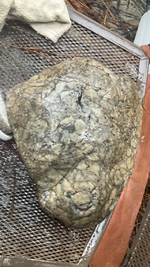Suiseki, Gongshi, Scholar's Rocks, are
prized because they evoke natural landscapes or other objects, creatures etc. The most valuable do that because they do it by themselves for the most part. The more altered they are, the less 'natural' they become and resultingly, the less regarded. It's easier to pick up a stone, make alterations and enhancements than it is to find a stone that "speaks for itself" without additional work. Anyone who has looked for suiseki in nature knows those kinds of stones are pretty rare.
That said, many excellent suiseki
have been altered in some form. It's just been done expertly and the work on the best stones is not obvious.
I wish I cld offer the link. Rather all I can offer is to say “the information out there on the Internet, and can be found”.
If I’m not mistaken, Japanese society is Renown for using indirect communication. That said, I think Suiseki Itself has only been around since the 1930s though though I’m doubly it’s a derivative of an art form that goes back over 2000 years. At one point in the history of Suiseki, You get the impression that there was too much rigidity in “the rules” to the point, where it greatly detracted away from the enjoyment of the art form. It was undecided, that, for the betterment of the art, to attract more people, to be a little less rigid with “the rules“. Enter The philosophy of cut stones, or “any cut that improves. The quality of the stone is permissible” (I paraphrase, but that’s the gist of it).
Somewhere between biseki, Which is a highly manipulated near-perfectionist stone artform, and “NO manipulations of ANY kind!” (i.e. rubbing, buffing, WATERING for the affect of altering a stone’s appearance), seems to lay the intended target of the Culmination, of views, that gave birth to modern, suiseki.
After all, #1 MOST important!!! It SHOULD be enjoyable! I think it’s nearly impossible to have deep appreciation (in most cases) “Enjoyment” is not also present!
For instance: I LOVE this stone!! I Often wondered to myself how rare of a find it is to come across a metamorphic rock that would, by complete happenstance, be shaped in the fashion of a sea turtle carapace (or a python’s head, Depending on your view).
I have not “altered” the Shape of the stone in anyway! To that end it’s pure! Having read On Bonsai Empire that was permissible to wire wheel, I found what I believed was dirt in the cracks of the stone, to be quite stubborn and removing and wire wheel to it. (Turns out I thought was “dirt“, Is rather a stone related to mold!!!… But that’s besides the point).
Point is: , Through my ignorance, somehow the rarity of this find is devalued. I had used a wire wheel and hand, buffed the stone based on ignorance and erroneous information from what I thought was a reliable source!
Now, technically, though it’s totally Copacetic by Japanese standards, but by American standards, it is now lumped into the same grouping of stones that have been manipulated and shaped by grinding discs: “Worked On”.
Values the stone greatly. Not just because it’s mine, but truly because I do appreciate the rarity of the find it doesn’t do the stone justice, and it most certainly detracts from my enjoyment of the art form!!
Especially since the wire wheel cleaning was an attempt to remove an organism that ultimately is harmful to the stone!!
I’m certain this is precisely why, Japanese allow for Certain degree of “manipulations”.
Same can he said for the Jaguars Left side profile, found pointing left on the left side of the Stone. I did not “buff” The jaguar into the stone!!
I did not grind or the jaguar to the stone!! All I did Use wire wheel in attempt to remove the same destructive mold, related microbe, And ignorantly buff the stone. Now it also is lumped into the “worked on category”, TOTALLY denying the absolute rarity of finding a Jasper with this 100% natural pattern and shape already existing in it!
Has nothing to do with my pride I’m just the duly who stumbled across the stone! But the “worked on” view is at best insulting to the spirit of the stone! It lowers its rightfully vaulted status, and labels it in a most undeserving fashion. Beyond the insult, such a statement is dishonest for the reality of this stones existence.
Personally, I don’t care to have anything to do with an art form that is that strict! BTW, the “second stone” isn’t a result of Effervescence, but rather Microbial growth! Which is more rare: a view built of cultivating common microbials, or a natural pattern, Present since the creation of the stone, where Natural happenstance, through various forms of erosion would create truly one of a kind view?
Maybe it’s time for us westerners to put a little more appreciation, in our statted “stone appreciation” hobby. Whether Softening of “rules” or a more standardized nomenclature. Cause As for the effect on the stone, either of these “worked on” stones are EVERY bit as rare a find, as a stone that’s ALSO been vigorously cleaned, oiled, and ESPECIALLY watered or even placed outside for the intent of enhancement! Probably rarer cause they’d BOTH exist nearly as amazingly w/o such enhancements as regular watering or even oiling. If I’d known, I wld hv just left them be, and allow the microbes to do what they will for my lifetime…I’d be near equally agitated if they belong to someone else! Clearly there’s some work to be done to our guidelines on how we literally view stones


